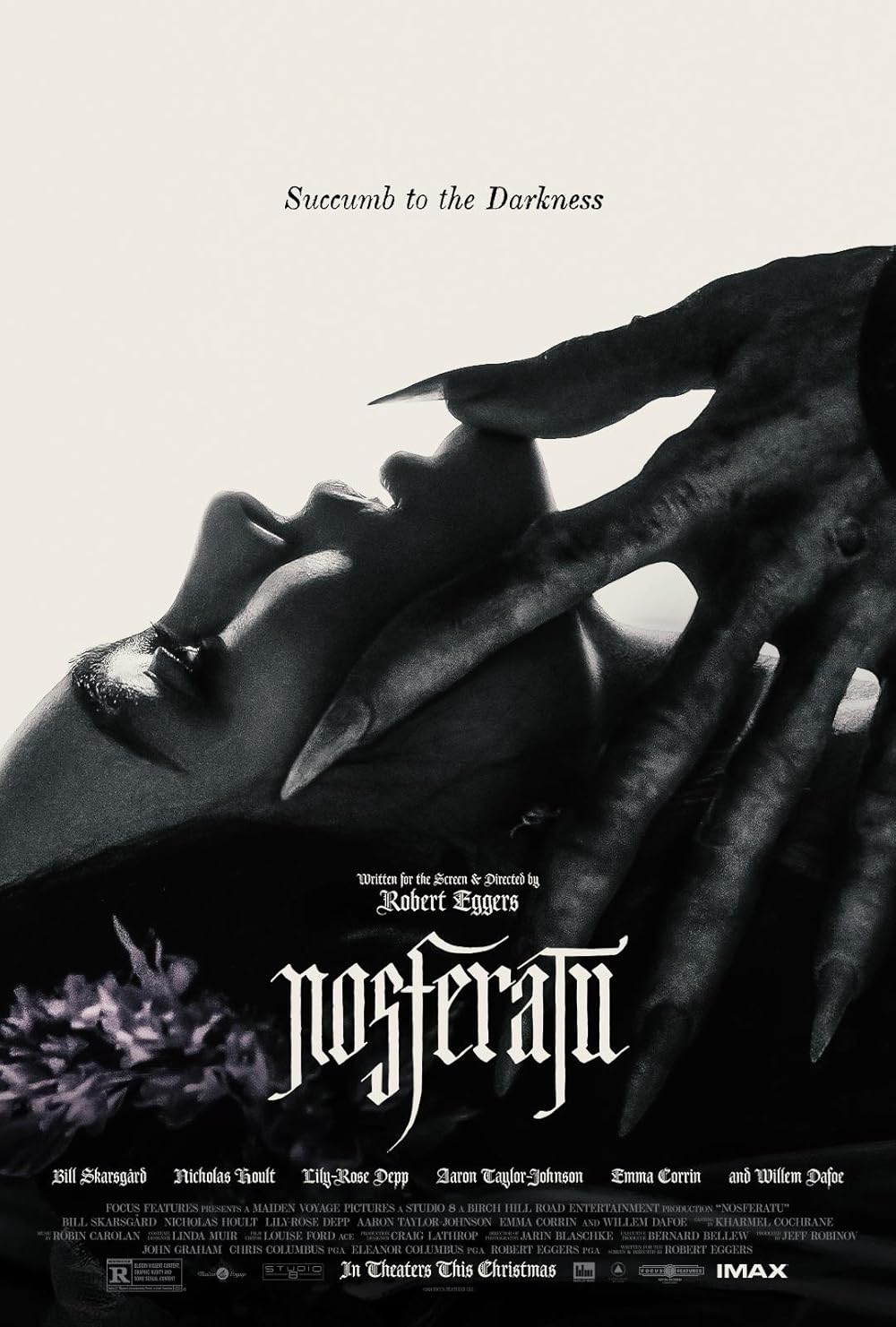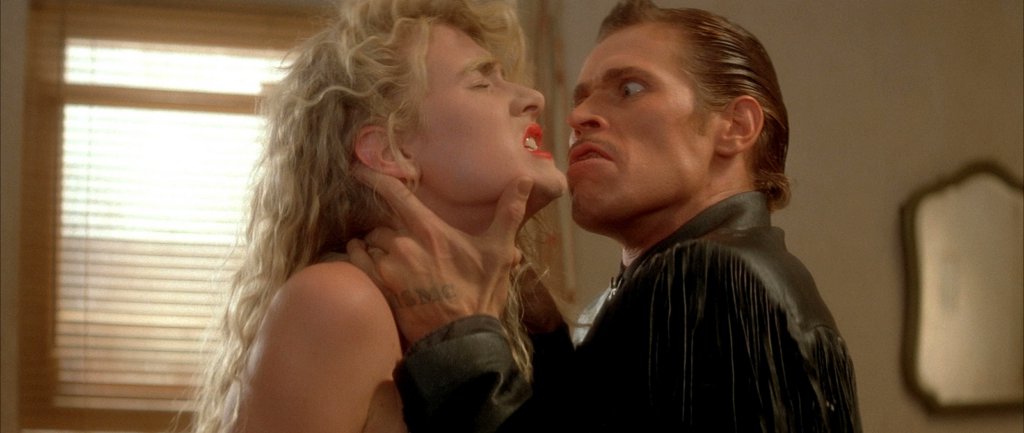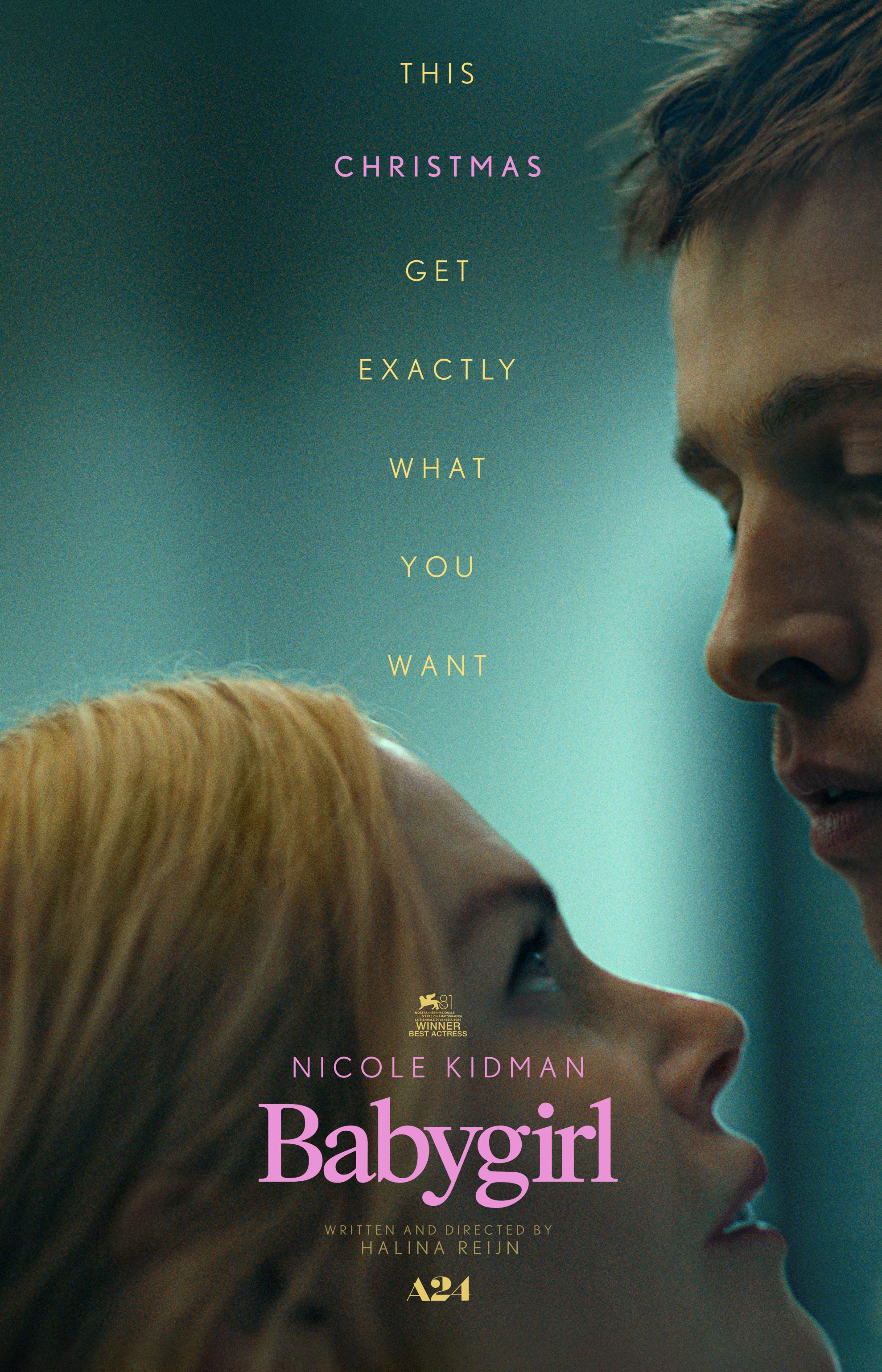“As far as Popescu was concerned, meanwhile, Dracula was simply a Romanian patriot who had resisted the Turks, a deed for which every European nation should to some degree be grateful. History is cruel, said Popescu, cruel and paradoxical: the man who halts the conquering onslaught of the Turks is transformed, thanks to a second-rate English writer, into a monster, a libertine whose sole interest is human blood, when the truth is that the only blood Tepes cared to spill was Turkish.” — Roberto Bolaño, 2666
“I will be your father figure, put your tiny hand in mine” — George Michael
Babyratu or Nosferbaby, the order doesn’t really matter unless it’s the order in which you watch them in. I saw them as a double feature after dinner on Boxing Day, and I am happy I did. The rightful (and lone) double feature successor to the mainstream Barbenheimer mania of a summer or two ago, this time the features landed on the artsier side of the mainsteam: with Nosferatu strictly marketed as Horror (and being another Eggers’s work of stylistic excellence) and Babygirl boasting the all important and portentious A24 tag on top of an obviously provocative premise.
I watched Nosferatu first, which was not an insignificant decision, and was a decision not insignificant to this critique. Why did I need to watch it first? It wasn’t simply logistics and it was at its simplest, me wanting to get the 'darker' picture out of the way before the true black of night set in, but why was I so scared? I had seen plenty of vampire movies before, seen plenty of Dracula— and let’s be clear, that is what Eggers made… a Dracula remake (it really is worth noting how trite changing the name to Nosferatu is when the movie is strictly a Bram Stoker’s Dracula remake with some slight changes, obviously there is the 1922 film precedent of Nosferatu, but when ‘remaking’ Nosferatu after Coppola’s Dracula was made 70 years later, and 32 years ago, you may as well call it Dracula even with a German setting, anyways… it’s murky). American audiences may have forgotten about Dracula, but capitalizing on that to feign novelty is shallow, if we may be permitted to assume that that was a contributing reason.
Anyways, why was I so scared? I have seen a litany of vampire movies and loved them with little fear or difficulty; I’ve seen the whole gamit from the silent Nosferatu to Coppola’s Bram Stoker’s Dracula, with it’s outrageous and touching ‘spy-kids’ costume design, to (my personal favorite) Polanski’s The Fearless Vampire Killers and even Abel Ferrera’s black and white modernizing of the vampire myth in The Addiction. But with Eggers’s (of who’s other movies I’ve seen none), I have always felt that he would take this genre film to layers of darkness without redemption that I was wary of. I am second-hand aware of the intensity and lack of 'salvific' components in his other works— even if they are well done and not 'evil'—, but with this film, and the marketing attatched I was worried he would take this mass spectacle, his biggest exposure yet, someplace horrific and irredeemable: and who wants to watch something that is only evil? Ultimately I was overly worried, crossing myself before and during the movie to avoid the projection of any bad juju, I mean how could you not worry given the direction he and his marketing team took for the film’s poster and release.

Succumb to the Darkness. So it is written above a woman at the verge of death or climax (these things are paired in the film ad naseum) and a sickly vampiric hand that entices/consumes her. This marketing direction was enough to made me wonder what sort of mass media event the public and I were walking into, and to be wary of what the screen might show us throughout.
And so begins the first screening, Robert Eggers’s Nosferatu. There is actually much less to say about this movie than one might first be inclined to. The movie is stylistically impressive. The sets, costumes, and the 'cinematography' are all well executed. One feels that Eggers may be the first to achieve Tim Burton 'realism', or in other words, to make what would (and maybe even should) be fantastical in style realistic. The mise en scène at time reaches highs that are the best I have seen in contemporary cinema, and there are many arrangements worthy of painting, not to mention a fantastic miniature scene reminiscent of Marnau’s Faust where the shadow of the vampire’s gaunt hand flies over the rooves of the corridored German city. The acting is decent with Nicholas Hoult (Thomas) giving by far the best performance and Aaron Taylor-Johnson (Thomas’s Friend) giving by far the worse. The sickly aspects of Lily Depp’s appearance are accentuated by the lighting and customing that surrounds her, and although her dialogue is weak (as is the film’s dialogue in general, bumbling and antiquated without elegance) she does continue to elicit emotion from the viewer and remains a proper casting choice. As for the plot, as previously mentioned, the film is a basically a Dracula remake with on important change and a handful of blasé ones.
The first scene of the film, which is also by far the scariest (an interesting and impressive feat, but also a bit of a let down as the film churns on favoring gore over terror), alerts us to the significant origins of Dracula and Lily-Rose Depp’s fated relationship, while simultaneously initiating us into the morbidly-orgasmic possesion-spasm that Depp’s character will experience what seems like one hundred of times before the film ends. Overall, the opening scene is well done, ending with a jump-scare demonaic choking Emma and then immediately vanishing, leaving her convulsing body and us (with the camera) flipped until we are buried in the earth under her. Before all of this, the movie opens with Emma praying for comfort, she is desperate and prays to “any being of any celestial sphere” for her much needed solace. It is not a particularly insidious prayer, and we have no context for why she is in such dire need of angelic assistance (at a mansion reminscent of Marienbad), but either way this ambigious prayer is what wakes Nosferatu from his slumber and chains his soul to hers irrevocably throughout the film. This is quite different from Stoker’s (and Coppola’s) description of the fatedness of the couple, in which, the count falls desperately in love with his lover from a past life, a love that both are destined to relive and sacrifice for.
The spiritual ontology this gives the movie, specifically its implications regarding Emma and Nosferatu’s natures are what give this movie any revelatory interest; given that the only other change of real importance compare to Stoker’s Dracula is Nosferatu never being presented as countlike or gentemanly. Simply put, Nosferatu is woken as a heavenly automata by Emma’s dangerously open ended prayer, it is quite apparent that he did not have much free will in the matter, and now must spin his mechanical course to brutally kill those she loves in progression until Emma succumbs to sleeping with him. The dual-sided elegance of the original Dracula, and Nosferatu’s mentioned lack of any gentlemanly aspect, make for him to be quite boring, a transformation that is only bearable as it imbibes Emma with a strong 'fatedness' into which the viewer can read a few decently interesting insights: one must assume these details to be Eggers’s main 'point' he wishes the viewer to ponder.
Quite simply, Eggers’s emphasizes that Emma, and all or a some women, have a darkly melded closeness to death and the occult. This is no novel insight, and even when the alchemical doctor (William Defoe) remarks that “I am simply a tourist in this realm, you have always lived in these (occulted) spheres”, we simply think “yes, that makes sense”. Woman are and always have been closely associated with death, the material world (in its highs and lows), and cleaner access to the divine; there is a reason oracles and sybills were female. Ultimately then, one can read the story, at its worst, as a modern fable of an innocent but overly thrill seeking young woman opening herself up to a thickly mustached, tall and skinny, stick-and-poke, musically inclined millenial and having an out of body fling with him only to have the thickly mustached man show up on her happily married doorstep years later as a reminder of all the near death climaxing she experienced in youth, this man then in his overly-husky voice demands to go at it one last time, or else… At its best, however, the film can be viewed as an elegant investigation into the aforementioned closeness of woman and death, of earth and death, of woman as the tragic seer and martyr for the one she loves.

Perhaps it was the casting of Defoe that kept me coming back to it, but I could not help thinking of Bobby Peru’s strange psychological rape of Laura Dern in Wild at Heart. Where, as in Nosferatu (and Peckinpah’s Straw Dogs), the woman ends up facing the darkest darkness alone: with no husband or lover for protection (they have innocently left or been tricked to leave) and no desire or ability to even inform their man or any other after the deed; left only with self-desecration and sacrifice that she must hold alone until the grave— a grave Emma finds quicker than most.
Strangely enough, Nosferatu’s best scenes (one remembers a beautiful shot of the deserted gypsie village at daybreak, or the shadowed crossroads where the vampire’s carriage meets Thomas (if only he could have also seen the blue lanterns on his way to the castle as in Stoker’s book)) have nothing to do with Emma or spiritual matters, but a combination of the two is what one is left with; beautifully stylized and suspense ridden scenes from the first half of the film overlayed by the contrite witness of an isolated and deistic female martydom. I’ll go and see Eggers’s next film even if this one did not reach the heights it could and should have, before that, however, we have one feature left: one of two contemporarily set movies I saw this year (the other unfortunately being The Substance), Halina Reijn’s Babygirl.

Since watching Nosferatu, I havn’t thought about it once. Since watching Babygirl, I have thought about it every day. That is not even to say it is a great movie, it could more reasonably be called a ridiculous movie, but maybe that doesnt matter now.
When I first looked at the poster for the film, I remarked outloud to my present audience that “He looks like Brad Pitt”. This insignificant remark turned out to embody my entire relationship with this movie. Who is this guy? He looks like Brad Pitt? Brad Pitt is a star, a leading man the likes of which we don’t have and havn’t had for a while. For all the glory that Kidman has won for her role, which is essential to the film and well done from start to finish, this movie is about Harris Dickinson, about his character and him more generally. Who is this guy? No, I havn’t bothered to watch his older films and likely won’t. I hadn’t heard about him before this film, but my younger sisters know him as one of their new hearthrobs; either way, this film is worth talking about exclusively because of him.
Halina Reijn’s script is ludicrous, and if you’re expecting realistic situations between the intern at the warehouse automation company (Tensile) and its CEO, you’re in the wrong place. However, for all its faults, the script is never jarring enough to completely dislocated us from the film’s viewing, instead it almost functions as an amplifier device to the already awakward and intense on-screen chronology. We can and must outright say how absurd, on many levels, it is (we could blame her European heritage?) for the young intern and CEO to be caught simultaneously going for a smoke on the balcony of their corporate offices, let alone him asking her for a light before she has even gone to smoke, but again, this is not what matters. Nor does it matter that Dickinson’s character Samuel (a name a bit heavy handedly chosen to echo the fact that he “knows things”. I guess people at A24 have started reading the bible like Banderas’s cuck-husband character at the end of the film), engages in games as silly as taking his married boss to brightly lit Brooklyn raves, ending in rooftop joint smoking sessions, or simultaneously engages in a public relationship with Kidman’s african-american and presumably ivy-league educated corporate-striver understudy. What matters is how wierd this character is, or really how wierd and committed and sexy and confused Dickinson is to pull it off.
From the first time we see Dickinson on screen, conveniently saving NYC pedestrians from a manic dog (an obnoxiously on-the-nose symbol that is repeatedly gone back to) outside the corporate office doors as Kidman is on her way to work, we are confused. Who is this guy supposed to be? He is tall, handsome, with a boyish but confident haircut, he is wearing unimpressive loose clothes and dons a backpack that is not hip or professional but instead something like a colorful Cotopaxi. So is he supposed to be an oblivious nerd? His next appearance leads one to believe something like this, as he abruptly questions Kidman about the sustainability of of Tensile’s growth plan at the cordial intern intro meeting. But ultimately he is not a nerd, he is not even a real person, he is beyond real but he speaks to something and someone trying to be real, he is the first ever artistic representation of the white collar wigger.
His character does not yet exist on this earth, and neither does Kidman’s, but they are just beyond reality, close enough to move us because they are more innocent then us all. As the movie moves on and we see Dickinson tatooed, Dickinson in his wife beater and hoodie, Dickinson talking in a calculating way that is common among those who are white collar but zoomer (raised on Migos and things of that sort), we see a new character; a character bold enough to bully his CEO to submitting to him completely for her sake? A character with an unreal confidence who bold-facedt ells his boss that she “likes to be told what to do” (Samuel’s “prophetic confidence” again) before making out with her in the soundproof conference room; a character, who holds the movie together not with some beautiful dialogue (“sometimes I scare even myself”…), not with a grand moral act (you will find no moral or epic intelligence in this tale, which is okay even though it is obviously being attempted), but with the calm dancing of his shirtless body as he serenades Kidman during the height of their romance.

This scene, Kidman sitting on a roccoco armchair smirking cross-legged and bathrobed, Dickinson again revealing his tattoos so perfectly emblematic of the white collar wigger (a small cross, an armed cupid in a ski mask, and a large snake which one must hope is a prop), Dickinson drinking some brown liquor glimmering the same as his chain… what in the world are we watching and why does it matter? Why does one of the two millenial masterpieces of the past 15 years (Spring Breakers and Uncut Gems) also deal exclusively in wiggers, but in the more traditional floridian Riff-Raffian sense. Because, they are what matter, they are what exists everywhere from the miami traphouse to the Manhattan white collar internship and everywhere in between. Does Dickinson’s character have no fear? This internship is no laughing matter, presuming a degree from a prestigious college, dedicated planning and applications, yet none of this seems to matter to him given the stunts he calmly pulls, we don’t even ask ourselves these questions while we watch him, we simply marvel in the intense strangeness and half-familiarity that Reijn, Kidman, and Harrison have conjured.
To finish out the critique, we must remark that the soundtrack, done by Christobal Tapia de Veer, is fantastic, augmenting the movie’s quick movement with deep whirrings and synthetic womps that seem genuinely novel and inventive. The movie can also be applauded for being truly post-PC, making PC culture seem a baked in component of workplace and psycho-sexual dynamics without condoning or focusing on it with any real serious. As mentioned, the movie fails in attempts to make sweeping sexual, moral, or political statements even in its more overt attempts (for example Dickinson trying to update Banderas’s latinx sexual mores), but this is easily forgiven. What is not so easily forgiven is Reijn and her editor’s need to include one or two too many sex scenes involving Kidman: the most notorious of which being the movie’s overwraught finale where we crosscut between Dickinson in his wifebeater taking the feral dog for a walk and Kidman finally being fingered facedown to a real— and the first with him!— orgasm with her husband. It cannot be overstated how artless and revealing inclusions like this are. The lasting feeling Babygirl leaves one with is curiousness. And more than anything who is Harris Dickinson? He reveals himself in Babygirl to be someone with a potential for male stardom in a way Austin Butler, and his plastic surgery (the only endorsable male plastic surgery being Michael Cimino’s, and his subsequent denying of it), or Chalamet are unable to be, someone who can be a strange and new and male while still touching what is real.
— Tamar




评论 (0)